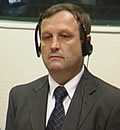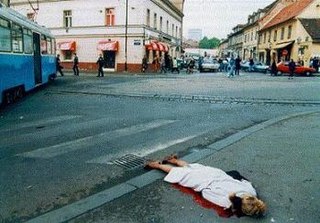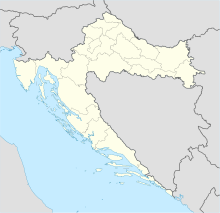
Milan Babić was a Croatian Serb politician and war criminal who served as the first president of the Republic of Serbian Krajina, a self-proclaimed state largely populated by Serbs of Croatia that wished to break away from Croatia during the Croatian War of Independence.

The Republic of Serbian Krajina or Serb Republic of Krajina, known as the Serbian Krajina or simply Krajina, was a self-proclaimed Serb proto-state, a territory within the newly independent Republic of Croatia, which it defied, and which was active during the Croatian War of Independence (1991–95). It was not recognized internationally. The name Krajina ("Frontier") was adopted from the historical Military Frontier of the Habsburg monarchy (Austria-Hungary), which had a substantial Serb population and existed up to the late 19th century. The RSK government waged a war for ethnic Serb independence from Croatia and unification with the Federal Republic of Yugoslavia and Republika Srpska.
The Plitvice Lakes incident was an armed clash at the beginning of the Croatian War of Independence. It was fought between Croatian police and armed forces from the Croatian Serb-established SAO Krajina at the Plitvice Lakes in Croatia, on 31 March 1991. The fighting followed the SAO Krajina's takeover of the Plitvice Lakes National Park and resulted in Croatia recapturing the area. The clash resulted in one killed on each side and contributed to the worsening ethnic tensions.

The Croatian War of Independence was an armed conflict fought in Croatia from 1991 to 1995 between Croat forces loyal to the Government of Croatia — which had declared independence from the Socialist Federal Republic of Yugoslavia (SFRY) — and the Serb-controlled Yugoslav People's Army (JNA) and local Serb forces, with the JNA ending its combat operations by 1992.
The Z-4 Plan was a proposed basis for negotiations to end the Croatian War of Independence with a political settlement. It was drafted by Peter W. Galbraith, Leonid Kerestedjiants and Geert-Hinrich Ahrens on behalf of a mini-Contact Group comprising United Nations envoys and diplomats from the United States, Russia and the European Union. The co-chairs of the International Conference on the Former Yugoslavia, David Owen and Thorvald Stoltenberg, were closely involved in the political process surrounding the plan. The document was prepared in the final months of 1994 and early 1995 before being presented to Croatian President Franjo Tuđman and the leaders of the self-declared Republic of Serbian Krajina (RSK) on 30 January 1995. Tuđman was displeased with the proposal, but accepted it as a basis for further negotiations. However, the RSK authorities even refused to receive the document before UNPROFOR mandate status was resolved. According to later reactions, RSK leadership was not satisfied with the plan.

Milan Martić is a Croatian Serb politician and war criminal who served as the president of the unrecognized Republic of Serbian Krajina, a self-proclaimed state largely populated by Serbs of Croatia that wished to break away from Croatia during the Croatian War of Independence.
The Lovas killings involved the killing of 70 Croat civilian residents of the village of Lovas between 10 and 18 October 1991, during the Croatian War of Independence. The killings took place during and in the immediate aftermath of the occupation of the village by the Yugoslav People's Army (JNA) supported by Croatian Serb forces and Dušan the Mighty Forces. On 10 October, two days after Croatia declared independence from Yugoslavia. The occupation occurred during the Battle of Vukovar, as the JNA sought to consolidate its control over the area surrounding the city of Vukovar. The killings and abuse of the civilian population continued until 18 October, when troops guarding a group of civilians forced them to walk into a minefield at gunpoint and then opened fire upon them.
The Škabrnja massacre was the killing of 62 Croatian civilians and five prisoners of war by Serbian Autonomous Oblast Krajina Territorial Defence troops and the Yugoslav People's Army (JNA) in the villages of Škabrnja and Nadin east of Zadar on 18–19 November 1991, during the Croatian War of Independence. The massacre occurred shortly after an agreement to evacuate Zadar's JNA garrison following an increase in fighting between the Croatian National Guard and the JNA. Most of the killings were committed by SAO Krajina troops which followed the leading armoured JNA units fighting their way into Škabrnja on 18 November. During the initial attack, the attacking force employed a human shield of captured civilians forced to walk in front of armoured vehicles. Most of the civilian population fled the village and about 120–130 were captured by the JNA and detained in the village school and kindergarten. However, others who took shelter in basements were killed in or just outside their homes. A portion of those killed in the massacre were buried in a mass grave in Škabrnja, while dozens of bodies were turned over to Croatian authorities.
The Baćin massacre was the killing of 83 civilians just outside the village of Baćin, near Hrvatska Dubica, committed by Croatian Serb paramilitaries. The killings took place on 21 October 1991 during the Croatian War of Independence. Most of the civilians were Croats, but they also included two ethnic Serbs, taken from Hrvatska Dubica, Baćin and the nearby village of Cerovljani. The civilians were killed in the area of Krečane, at the very bank of the Una River, and their bodies were left unburied for two weeks. Most of them were subsequently bulldozed into a shallow mass grave, while a number of the bodies were thrown into the river. Further killings of Croat civilians continued in Baćin and surrounding areas until February 1992.

The Zagreb rocket attacks were two rocket attacks conducted by the Army of the Republic of Serbian Krajina that used multiple rocket launchers to strike the Croatian capital of Zagreb during the Croatian War of Independence. The attack killed seven and wounded over 200 Croatian and foreign civilians and was carried out on 2 May and 3 May 1995 as retaliation for the Croatian army's offensive in Operation Flash. The rocket attacks deliberately targeted civilian locations. Zagreb was the largest of several cities hit by the attack. It was not the only instance in the war in Croatia that cluster bombs were used in combat.
The Saborsko massacre was the killing of 29 Croat residents of the village of Saborsko on 12 November 1991, following the seizure of the village in a Yugoslav People's Army and Croatian Serb offensive during the Croatian War of Independence. The fall of the town occurred as part of a JNA and Croatian Serb operation to capture a Croatian-held pocket centered on the town of Slunj, southeast of Karlovac. While the bulk of the civilian population fled with the surviving Croatian forces, those who remained in Saborsko were rounded up and either killed or expelled. The bodies of the victims were retrieved from two mass graves and several individual graves in 1995.
The Velepromet camp was a detention facility established in the final days of the Battle of Vukovar during the Croatian War of Independence. The camp was set up by the Yugoslav People's Army (JNA), which shared control of the facility with Croatian Serb rebels. The facility, originally an industrial storage site, was located on the southern outskirts of the city of Vukovar, in close proximity to the JNA barracks. It consisted of eight warehouses surrounded by a wire fence, and was established on 16 November 1991, when the first detainees were brought there.
The Dalj massacre was the killing of Croats in Dalj, Croatia from 1 August 1991 until June 1992, during the Croatian War of Independence. In addition to civilian victims, the figure includes 20 Croatian policemen, 15 Croatian National Guard troops and four civil defencemen who had been defending the police station and water supply building in the village on 1 August 1991. While some of the policemen and the ZNG troops died in combat, those who surrendered were killed after they became prisoners of war. They tried to fight off an attack by the Croatian Serb SAO Eastern Slavonia, Baranja and Western Syrmia Territorial Defence Forces, supported by the Yugoslav People's Army and the Serb Volunteer Guard paramilitaries. The SAO SBWS was declared an autonomous territory in eastern Croatia following the Battle of Borovo Selo just to the south of Dalj.
The Erdut killings were a series of murders of 37 Hungarian and Croat civilians in the village of Erdut, Croatia committed by Croatian Serb forces and Serb Volunteer Guard paramilitaries between November 1991 and June 1992, during the Croatian War of Independence. Twenty-two Hungarians and 15 Croats were killed. The first killings occurred on 10 November 1991, when twelve civilians died. Eight more were killed over the following several days. Five more civilians were killed on 10 December, and another seven on 16 December. Four others were killed on 21 February 1992 and the final one was killed on 3 June. The bodies of these victims were either buried in mass graves or thrown into nearby wells.
The Golubić killings was the mass murder of at least 18 Serb civilians from the village of Golubić in the county of Šibenik-Knin County on 6 August 1995, by members of the Croatian Army (HV) during Operation Storm.
The Gošić kllings refers to the mass murder of elderly Serb civilians from the village of Gošić in Šibenik-Knin County by members of the Croatian Army (HV) on 27 August 1995, approximately three weeks after Operation Storm.
The Komić killings refers to the mass murder of elderly Serb civilians from the village of Komić in August 1995 by members of the Croatian Army (HV), five days after Operation Storm.
The Uzdolje killings was the mass murder of at least ten Croatian Serb civilians from the village of Uzdolje, near Knin on 6 August 1995 by members of the Croatian Army (HV) in the aftermath of Operation Storm.
The Grubori massacre was the mass murder of six Serb civilians from the village of Grubori, near Knin, on 25 August 1995 by members of the Croatian Army (HV) in the aftermath of Operation Storm. The massacre was listed in the ICTY's indictment of Croatian wartime generals Ante Gotovina, Ivan Čermak and Mladen Markač.
On 7 August 1995, two Croatian Air Force MiG-21 planes fired several rockets at a Serb refugee column on a road near Bosanski Petrovac, Bosnia and Herzegovina, killing 9 civilians and injuring more than 50. On 8 August 1995, another attack took place, resulting in more civilian casualties. The victims were traveling in a refugee column fleeing Croatia during Operation Storm which brought about an end to the Croatian War of Independence.






